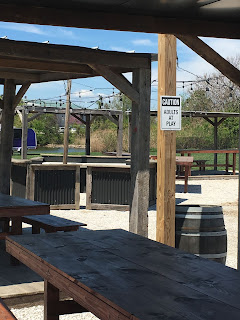 |
| New fun zone "Southpoint" at West Covington: Much more barren than "Sandlot" at Harborpoint (Photo Philipsen) |
The park opened to the public in 2015.
In 2018 much of the initial design has been removed in favor of an outdoor bar called "Southpoint" operating out of containers and trailers. Recently a large tent and a stormwater rock catch bassin were added. A large part of the most important elements for conservation and habitat restoration has been removed: The vegetation. The recreational pier, the gateway and some educational signage and trails are still in place.
What happened?
The City sold the contaminated brownfield to the Aquarium in 2007 for $250,000. The Aquarium wanted to build an aquatic life center here but eventually withdrew from the project after spending about $3 million for environmental clean-up of the polluted site and over $4 million for the park design including a federal grant and State money. They thus fulfilled the City's requirments set forth in the land disposition agreement. In December 2016 the Aquarium sold the land to Sagamore Development which is now called Weller Development for $4.63 million. Apparently Weller sees benefit in more active uses on the parkland.
 |
| Drinks instead of birds: West Covington Park (Photo Philipsen) |
In Baltimore where resources are always scarce, the partial undoing of a brand-new park is pretty unsettling for a number of reasons:
- removal of hundreds of plants that had barely a chance to grow seems like a big waste
- converting a habitat restoration on the fragile Middle Branch into ballfields and an "adult playground" is environmentally a step backwards
- the removal of the waterfront vegetation seems counter to the goals set forth in the Port Covington Masterplan which are supposedly grounded on ecological principles developed by Biohabitats, a consultant to Sagamore. The Port Covington Masterplan is quite specific:
The Port Covington Master Plan embraces the goals of improving water quality, providing a natural environment for fish and waterfowl, and creating a public amenity in an urban setting. [...] Restore and enhance shoreline habitats that promote connectivity to the Middle Branch of the Patapsco River, and life throughout the Chesapeake Bay. [...] Restore and maximize habitat for waterfowl, neo-tropical songbirds and indigenous resident birds and bats. Explore ecological function of parcels prior to development; create temporary landscape installations beneficial to wildlife and water management. Use biomimicry to design urban habitat and water features. (Masterplan)The Port Covington masterplan mentions West Port Covington Park only in passing as a "privately owned publicly accessible park". No mention is made in regards to its future disposition, even though in renderings it was shown as a park with the original design.
 |
| The West Covington Park as originally designed |
If folks were angry about that Christmas tree debacle they should be furious about this! (Facebook entry on a discussion about West Covington Park)The use of parts of the park for an outdoor beer garden, exercise field and sandlot will certainly draw additional users to the site, similar to Sandlot on HarborPoint, a hugely popular pop-up bar and adult playground and Nick's Fish House just on the other side of the Hanover Street bridge and connected to the West Covington Park by a bike and hike trail. The question is,
- how the modification complies with requirements for design in in Critical Areas (the zones along the tidal waters of the Chesapeake Bay and its tributaries
- how the removal of Critical Area vegetation is mitigated
- and how the new design fits with the original goals which included habitats and wildlife.
 |
| Lawns do little to contain runoff or provide habitat: The park after the removal of the plants and trees (Photo Philipsen) |
One has to assume that Weller Development is now more removed from Kevin Plank and the Under Armour corporation and that the development of Port Covington is less driven by a new Under Armour headquarters which originally was the driver. UA has reduced the number of employees at Tide Point, presumably making a move and a costly new campus less urgent and likely.
 |
| The original vegetation (ASG website) |
While the urgency has changed, Weller Development maintains that things continue to move along as planned. "Chapter 1" development north of the Sagamore distillery was recently presented to the City's design review panel. The Weller team also has continues its contact with the SB7 group of communities which are engaged under the large community benefits agreement that was part of the $600 million plus TIF agreement. At this point, no TIF bonds have been issued and, accordingly, no TIF money has been drawn.
 |
| Sagamore sign on the site still espouses wild life (Photo Philipsen) |
The changes on West Covington Park may not be a big deal in the context of the 250 acre Port Covington "new town". But it could be a sign for a less innovative approach. Beer drinking has always trumped bird watching.
Klaus Philipsen, FAIA
Article on Community Architect Daily about the Park: Baltimore's newest park at West Covington
Baltimore Brew about the opening of the park
Baltimore Brew about the recent changes
No comments:
Post a Comment